Stable Cell Line Generation
Service Request FormStable cell lines, expressing a gene of interest or harboring knockout, knockin or precise sequence changes (e.g. point mutation) at a defined locus, are widely used in recombinant protein and antibody production, drug screening, gene functional studies and other applications. Stable cell lines can overcome the variation associated with transient transfection and grow continuously over a prolonged period of time and stably carry a genetic modification or express a transgene without significant changes in expression levels. In most cases, the development and production of a qualified stable cell line is a complex and time-consuming challenge, which requiring extensive experience and technique.
ALSTEM can provide one-station services for establishing stable cell lines with customized genetic modifications at unbeatable prices with rapid turnaround. Our solid expertise in lentiviral technology enables us to efficiently generate stable cell lines to meet the requirements of reporter cells that express RFP/GFP/ luciferase for high-throughput assays, overexpression cells to study your protein-of-interest, TET inducible cells or customized cells for any research application. We can design and generate tailor-made vectors according to your experimental needs and the characteristics of your specific cell lines. We have access to a range of technologies and an expert team experienced at working with a variety of cell lines, including adherent and suspension cells. Chemical transfection, electroporation or viral transduction will be employed where appropriate to introduce the desired DNA changes. After standard drug selection, polyclonal cell populations or monoclonal cell lines will be sub-cultured, verified and delivered to you ready for use.
Our stable cell line generation service area:
- Luciferase/Nanoluciferase/GFP/RFP pre-labeled stable cell line
- HiBiT tagged stable cell line
- Androgen response element driven luciferase reporter stable cell line
- Target gene overexpression stable cell line
- TET (on/off) inducible cell line
- Customized stable cell line generation
Customer will provide:
- Customer-desired cells, 2 vials of typical storage size, and indication of appropriate growth medium and conditions. If your cells require medium other than DMEM and RPMI, we will need 1-2 L of medium and any applicable growth factors from you for the project. Also, please provide coated 6-well plates and T25 flasks if the cells require specially treated culture vessels.
- If you wish to prepare your own DNA, we ask that you provide between 10-400 µg of DNA depending on the requested titer. We also provide plasmid amplification, custom vector construction at additional cost.
- Detailed information regarding target gene and type of modification required (please fill out a service requisition form)
Deliverables
- Two vials (>1 x 106 cells/vial) of pooled cells and/or single clone cells.
- Milestone reports and detailed final report
To request further information or a quote, please CONTACT US.
Our stable cell line generation service workflow.

Our stable cell line generation service timeline:
| Services | Description | Deliverables | Timeline |
|---|---|---|---|
| Construct generation (Optional) |
|
|
1 week |
| Virus Packaging |
|
|
1 week |
| Stable cell clone selection |
|
|
4-5 week |
Case Studies
Click to ReadCase 1: Luciferase and tdTomato dual-labeled HeLa stable cell line:
Firefly luciferase is commonly used as a genetic reporter to assess the transcriptional activity of a construct with luciferase gene under the promoter of interest. We first tested the function of two different promoters, SFFV and CMV, which drive the expression of luciferase, on five different cell lines. Although luciferase activity varies in different cell lines, the SFFV promoter showed much stronger luciferase expressing than that of CMV promoter in each cell line (Figure. 1). Here, Luciferase and tdTomato dual-reporter HeLa cell line is derived from HeLa cells by transduction of ALSTEM’s pLenti-SFFV-Luciferase-PGK-tdTomator-T2A-PURO Lentiviral Reporter (cat# LV452) lentivirus. The cell line stably expresses firefly luciferase at high level since it is driven by SFFV promoter. It also expresses a red fluorescent protein marker (tdTomato) and puromycin resistance gene, which are driven by PGK promoter (Figure 2). Luciferase/tdTomato dual-reporter HeLa cells can be a very useful cell line for non-invasive visualization in both in vitro and in vivo experiments.
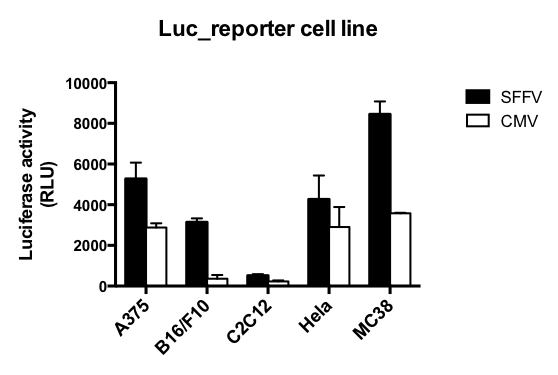
Figure 1. Comparison of the efficiency of SFFV and CMV promoters to drive the luciferase expression. Each cell line was infected using in house packaged SFFV/CMV_luciferase lentivirus at same MOI (~2-3). The results suggested that the luciferase activity varies in different cell line, while the SFFV promoter shows much stronger luciferase expression than that of CMV promoter in all cell lines.
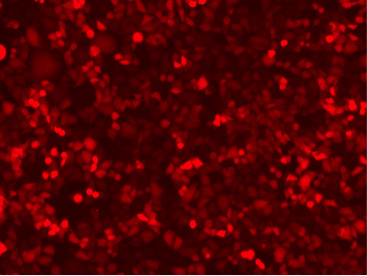
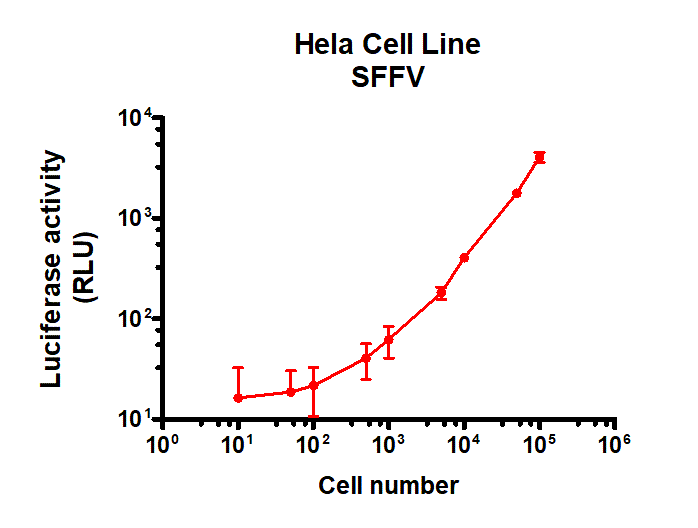
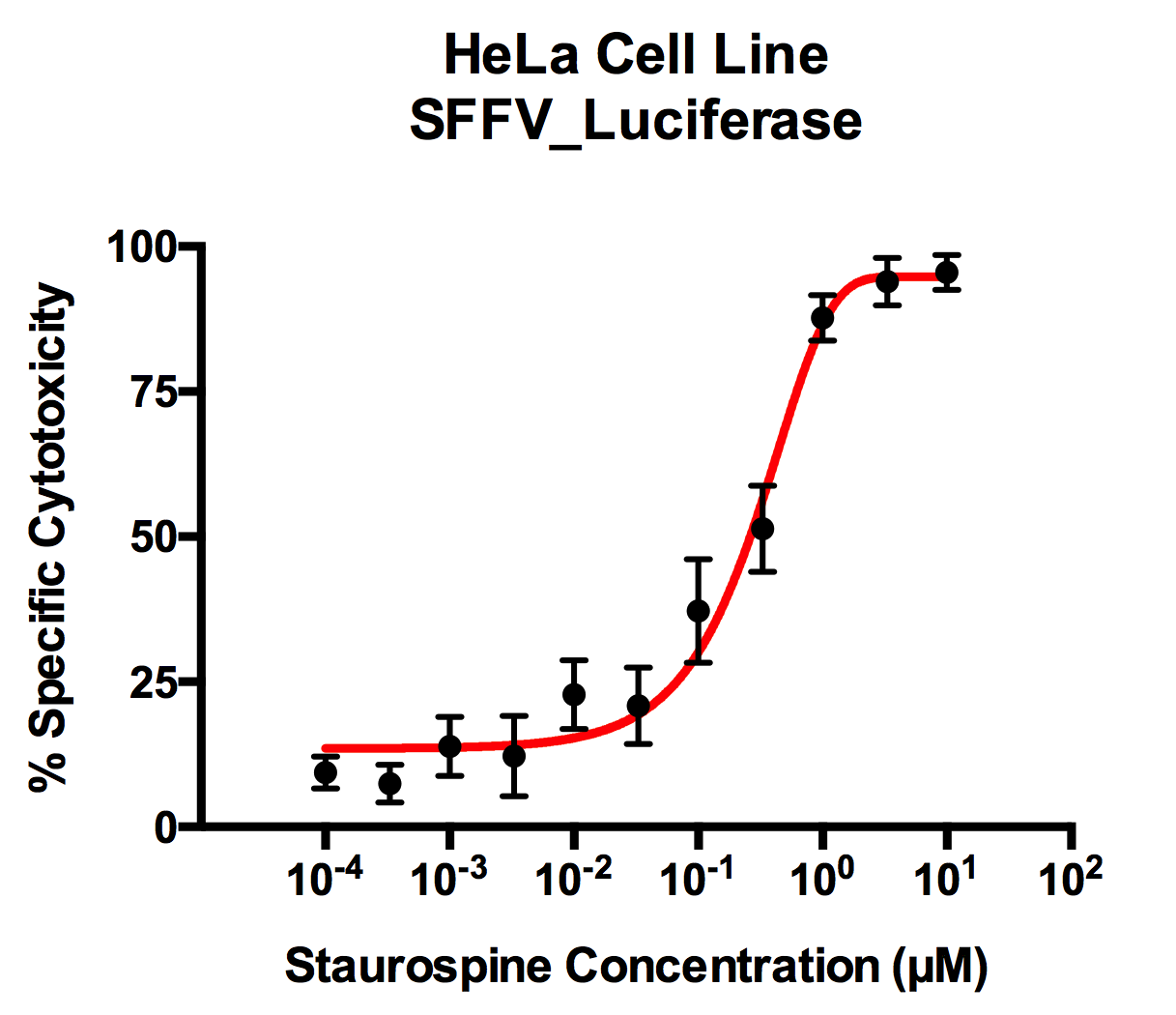
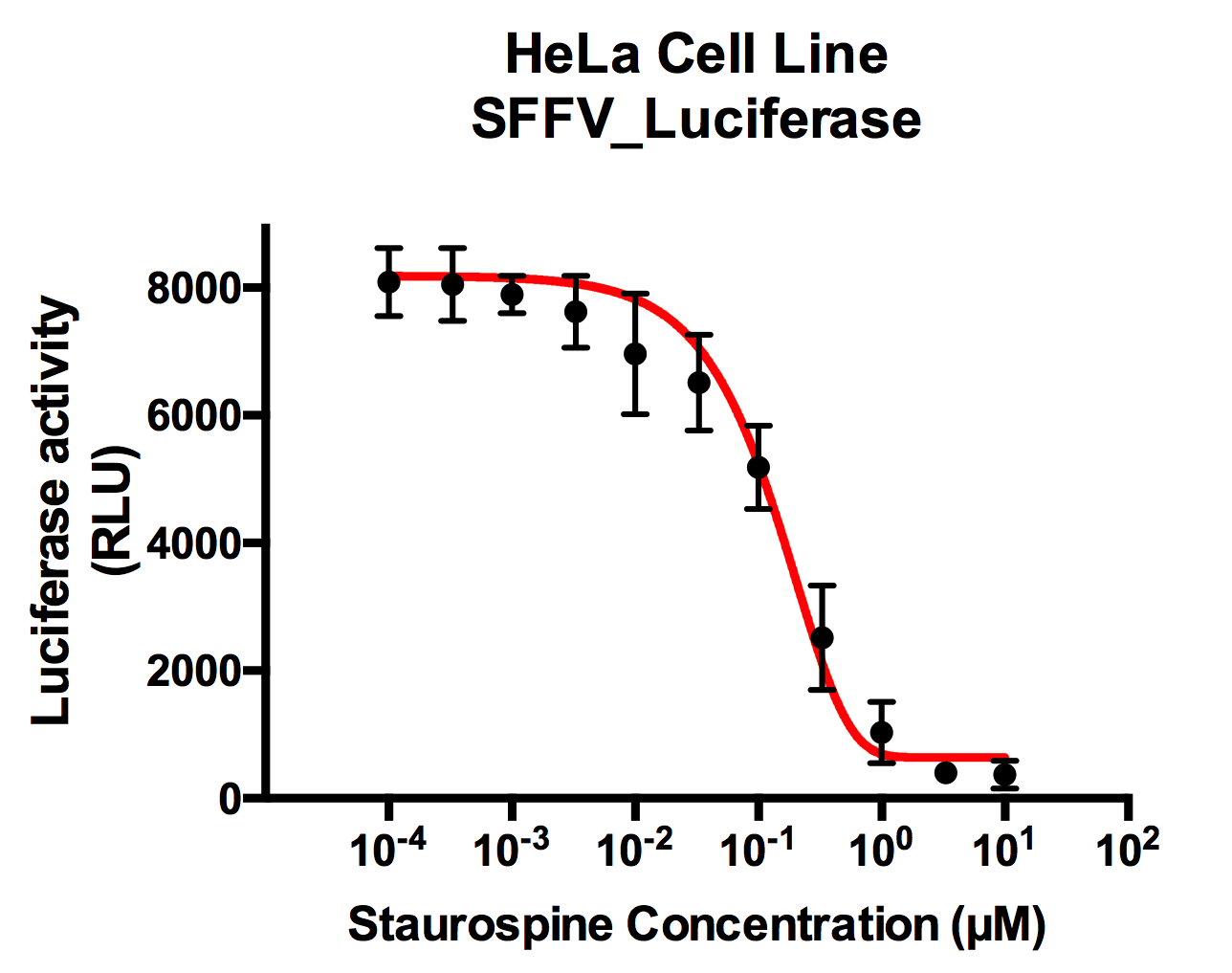
Figure 2. Panel A: RFP Fluorescence. Dual-labeled HeLa cell line expressing tdTomato at 90% cell confluence. The image was taken using a Nikon fluorescent microscope. Panel B: Luciferase activity. Serial dilutions of dual-labeled HeLa cells were plated into a 96-well plate. The luciferase activity was tested 6 hrs later. Panel C: Dose-response luciferase activity analyses in HeLa cell line after Staurospine treatment. Shown is luciferase activity change of HeLa cells after incubation with increasing concentrations (μM) of Staurospine for 24h. Panel D: Kinetic cytotoxicity assay. Shown is HeLa cell cytotoxicity onset in response to Staurospine dosing (EC50= ~0.1 uM). Data are expressed as mean /- SD from duplicates of three independent experiments.
Vector Information

Figure 3. The lentiviral reporter vector contains luciferase gene driven by SFFV promoter, tdTomato and puromycin resistance gene by PGK promoter.
Key Features:
- Excellent signal/background ratio
- Stable luciferase and tdTomato expression
- Ideal for in vivo bioluminescence imaging and cell-based assays for cancer research.
Case 2 Target gene overexpression stable cell line:
Recombinant stable cell lines are one of the widely used tools in drug discovery, toxicity testing, and basic research. Long-term stable expression of a gene of interest (GOI) is usually achieved by transfection or viral transduction of a vector containing the expression cassette of the GOI together with a selection marker (antibiotics or fluorescent proteins). In contrast to transient expression, stable cell line offers reproducible results for assay studies. Here, we packaged lentivirus and transduced a mouse cell line. The expression of transgenes was confirmed by FACS analysis Figure 4.
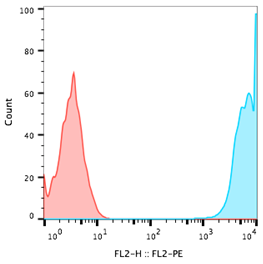
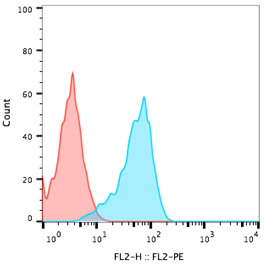
Figure 4. FACS analysis of a mouse cell line transduced with lentivirus. Assay was run on the transduced and parental cells. The left panel shows transduced cells stained with antibody against target protein verse parental cells, while the right panel transduced cells stained with another antibody against target protein verse parental cells. Both antibodies gave at least one log intensity positive shift (PE channel).
